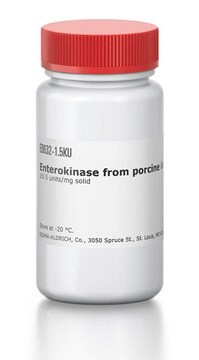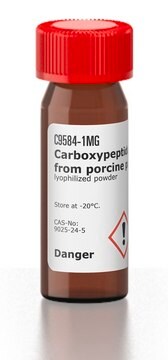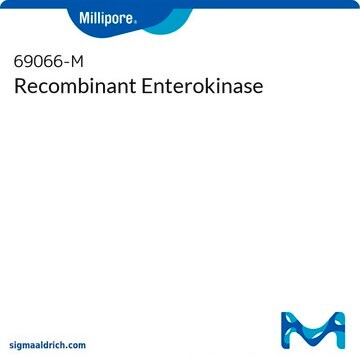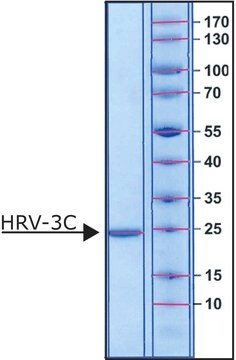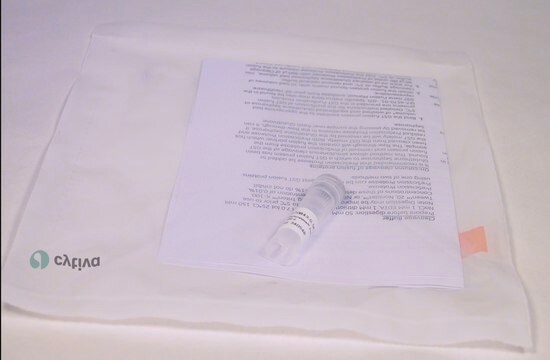Wszystkie zdjęcia(1)
Kluczowe dokumenty
E5144
Enterokinase from bovine intestine
powder
Synonim(y):
Enteropeptidase
Zaloguj sięWyświetlanie cen organizacyjnych i kontraktowych
About This Item
Polecane produkty
pochodzenie biologiczne
bovine intestine
Poziom jakości
Formularz
powder
masa cząsteczkowa
150 kDa (consisting of 115kDa and 35kDa subunits.)
kolor
white
Warunki transportu
dry ice
temp. przechowywania
−20°C
Szukasz podobnych produktów? Odwiedź Przewodnik dotyczący porównywania produktów
Opis ogólny
Enterokinase also referred to as enteropeptidase, is a transmembrane protein. This intestinal protease contains a heavy chain and a light chain linked by a disulfide bond. The amino-terminal sequence of the bovine enteropeptidase is homologous to trypsin-like serine proteases. Enterokinase is a highly specific serine protease that is used for the removal of the FLAG peptide from N-terminal and Met-N-terminal fusion proteins. It does not remove the C-terminal FLAG.
Zastosowanie
Enterokinase from bovine intestine has been used to remove S-Tag and N-terminal His-tag from recombinant glutathione peroxidase 1 (Gpx1). It has also been used to cleave interleukin-2 (IL-2) protein from the granules
Enterokinase is a member of the S1 peptidase family. In vivo, it is responsble for the proteolytic activation of trypsin from trypsinogen. Enterokinase is used for site specific cleavage of recombinant fusion proteins containing an accessible enterokinase recognition site for removal of affinity tags.
Działania biochem./fizjol.
Enterokinase catalyzes the proteolytic activation of pancreatic proteases. This action prevents the harmful tissue damage produced by the autoactivation of pancreatic proteases in the pancreas. Enterokinase recognizes Lys or Arg residues in the peptide. Lack of enterokinase can harm food digestion and absorption mechanism. Enterokinase is a highly specific serine protease that is used for the removal of the FLAG peptide from N-terminal and Met-N-terminal fusion proteins. It does not remove the C-terminal FLAG.
Opakowanie
Supplied with optimized enterokinase buffer
Definicja jednostki
One unit is that amount of enterokinase which results in >95% cleavage of 1 µg of purified FLAG-BAP fusion protein in 18 hours at 37 °C. One FLAG-BAP unit is equal to 10x the activity of a standard trypsinogen unit.
Inne uwagi
Do not used PVDF since free FLAG peptide will bind to the PVDF membrane.
Ta strona może zawierać tekst przetłumaczony maszynowo.
substrat
Numer produktu
Opis
Cennik
Kod klasy składowania
11 - Combustible Solids
Klasa zagrożenia wodnego (WGK)
WGK 3
Temperatura zapłonu (°F)
Not applicable
Temperatura zapłonu (°C)
Not applicable
Środki ochrony indywidualnej
Eyeshields, Gloves, type N95 (US)
Wybierz jedną z najnowszych wersji:
Masz już ten produkt?
Dokumenty związane z niedawno zakupionymi produktami zostały zamieszczone w Bibliotece dokumentów.
Klienci oglądali również te produkty
B Thomas Bäckström et al.
BMC biotechnology, 7, 3-3 (2007-01-06)
Fluorescence activated cell sorting (FACS) is a powerful technique for the qualitative and quantitative detection of biomolecules used widely in both basic research and clinical diagnostic applications. Beads displaying a specific antigen are used to bind antibodies which are then
Claude Castella et al.
Nitric oxide : biology and chemistry, 68, 125-136 (2017-02-15)
Plant glutathione peroxidases (Gpx) catalyse the reduction of various peroxides, such as hydrogen peroxide (H
Sang Youn Hwang et al.
Colloids and surfaces. B, Biointerfaces, 94, 296-303 (2012-03-09)
Encapsulation of active proteins in the hydrophilic core of vesicular liposomes is important for developing a therapeutic protein carrier system. The efficiency of liposomal encapsulation of proteins is generally low. A better understanding of the fundamental mechanisms of encapsulation is
Katrin Grage et al.
Applied and environmental microbiology, 77(18), 6706-6709 (2011-08-02)
A novel approach to produce purified recombinant proteins was established. The target protein is produced as polyhydroxyalkanoate (PHA) synthase fusion protein, which mediates intracellular formation of PHA inclusions displaying the target protein. After isolation of the PHA inclusions, the pure
Fengyun Li et al.
Analytica chimica acta, 724, 104-110 (2012-04-10)
Bioluminescence resonance energy transfer (BRET) has gained favors in recent years as a detection technology for protease activity due to its extreme reliability, high sensitivity and low intrinsic backgrounds. Because of the sensitivity of the donors, substrates and the acceptors
Nasz zespół naukowców ma doświadczenie we wszystkich obszarach badań, w tym w naukach przyrodniczych, materiałoznawstwie, syntezie chemicznej, chromatografii, analityce i wielu innych dziedzinach.
Skontaktuj się z zespołem ds. pomocy technicznej
